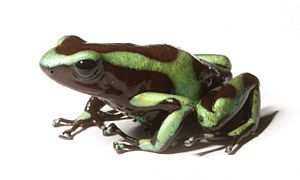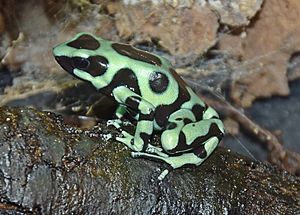Green and black poison dart frog facts for kids
Quick facts for kids Green and black poison dart frog |
|
|---|---|
 |
|
| D. auratus from Panama | |
| Conservation status | |
| Scientific classification | |
 |
|
| Range in red (Hawaiian population introduced) |
The green-and-black poison dart frog (Dendrobates auratus) is a colorful frog. It is also known as the green-and-black poison arrow frog. These frogs live in Central America and parts of northwestern South America. They have also been brought to Hawaii. This frog is one of the most varied types of poison dart frogs. The International Union for the Conservation of Nature says it is not currently in danger.
Contents
About the Green-and-Black Poison Dart Frog
This frog looks like other frogs in its family. Male frogs are about 0.75 inches (1.9 cm) long. Females are a bit bigger, often an inch (2.5 cm) or more.
The green-and-black poison dart frog usually has a mint-green color. But it can also be forest green, lime green, or even turquoise. Some can be cobalt blue or pale yellow. These bright colors are mixed with dark spots. These spots can be brown or black. This frog has many different patterns. Some have black or brown blotches. Others have splashes of black, like paint.
Where These Frogs Live
You can find the green-and-black poison dart frog in wet, low areas. They live from southeastern Nicaragua to northwestern Colombia. They were brought to Oahu, Hawaii, in 1932. This was done to help control mosquitoes. Later, they also started living on Maui.
The Frog's Poison
The green-and-black poison dart frog is very toxic. It is not the most poisonous dart frog, but it is still dangerous. A very small amount of its poison can be enough to stop a human heart.
However, these frogs only release their poison if they feel threatened. If a person handles a wild frog calmly, it might not release poison. When these frogs are kept as pets, they lose their poison. This happens because their diet changes. Scientists think the frogs get their poison from the mites and insects they eat in the wild.
Frog Behavior and Habits
The green-and-black poison dart frog spends some time in trees. They hunt, find mates, and sleep in the trees. But they are small and cannot jump far between trees. So, they go down to the ground when they need to travel.
To help them climb, these frogs have small, sticky pads on their toes. These pads create a slight suction. This helps them grip surfaces as they climb.
Life Cycle and Reproduction
Green-and-black poison dart frogs gather in large groups before they mate. The male frogs will argue over small areas of land. Each male then clears a small spot for himself. Female frogs walk among the males. The males try to impress the females with calls that sound like birds.
Once a male gets a female's attention, he leads her to a spot for laying eggs. The female lays her eggs, and the male fertilizes them. After about 14 days, the eggs hatch into tadpoles. The parents, usually the male, then carry the tadpoles. The tadpoles stick to the mucus on their parent's backs.
The parents then put the tadpoles into small pools of water. These pools often form in the center of plants called bromeliads. The parents guard the tadpoles. The tadpoles eat algae and tiny insects in the water.
Keeping Them as Pets
Green-and-black poison dart frogs are popular exotic pets. People like their small size, bright colors, and interesting actions. Like all frogs, their skin can absorb things easily. Because of this, you should not handle them.
See also
 In Spanish: Dendrobates auratus para niños
In Spanish: Dendrobates auratus para niños



